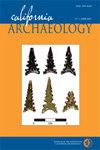Protohistoric Village Organization and Territorial Maintenance: the Archaeology of Síi Túupentak (ALA-565/H) in the San Francisco Bay Area
IF 0.7
0 ARCHAEOLOGY
引用次数: 3
Abstract
The Center for Archaeological Research at UC Davis (CARD) has published Volume 20 in their series focused on California and Great Basin ethnography, environment, and prehistory. This latest edition is yet another important contribution to ancestral California Native American culture. The volume’s many contributors address a broad range of topics and have prepared a report that is arguably one of the most thorough analyses of a Late Period village site in the archaeological literature of the San Francisco Bay region to date. The authors identify the site as within the territory of the CausenOhlone polity, whose members were inducted into Mission San José shortly after its founding in 1797. Dubbed Síi Tuúpentak by the project’s Muwekma Tribal partners (which in the Chochenyo East Bay dialect translates to “Place of the Water Roundhouse”), the village developed in an area that was intermediary between bay shore populations and those residing further inland. Strategically situated within an oak woodland savannah setting behind the East Bay hills in Sunol along Alameda Creek, the residents were ideally placed to benefit from the flow of resources between neighboring and more distant polities. The report goes deep into the weeds describing the site within the framework of its environmental setting, and paleoethnobotanical studies derived from feature and burial contexts provide a wonderfully detailed spectrum of vegetal resources important to the subsistence and economy of the village’s members. Equally impressive are the discussions of the important representations of aquatic and terrestrial dietary fauna derived from careful analysis of selected samples. Far Western Anthropological Research Group (FWARG) describes how the site underwent a series of archaeological investigations in response to developmental impacts, resulting in the exhumation of 76 individual burials along原历史村落组织与领土维护:旧金山湾区Síi Túupentak (ALA-565/H)考古
加州大学戴维斯分校考古研究中心(CARD)出版了第20卷,集中在加利福尼亚和大盆地人种学、环境和史前史方面。这个最新版本是对祖先加州印第安文化的又一重要贡献。该卷的许多贡献者解决了广泛的主题,并准备了一份报告,可以说是在旧金山湾区的考古文献中对一个晚期村庄遗址最彻底的分析之一。作者将该遗址确定为在CausenOhlone政体的领土内,该政体的成员在1797年成立后不久就加入了圣约瑟教会。该项目的Muwekma部落合作伙伴将其命名为Síi Tuúpentak(在Chochenyo东湾方言中翻译为“水上圆屋的地方”),这个村庄在海湾沿岸人口和居住在内陆的人口之间发展起来。战略性地坐落在Sunol沿着Alameda Creek的东湾山丘后面的橡树林地大草原上,居民们理想地从邻国和更远的政治之间的资源流动中受益。该报告深入研究了杂草,在其环境背景的框架内描述了该遗址,而从特征和埋葬背景中得出的古民族植物学研究提供了对该村成员的生存和经济至关重要的植物资源的非常详细的光谱。同样令人印象深刻的是,通过对选定样本的仔细分析,对水生和陆生食性动物群的重要代表进行了讨论。远西部人类学研究小组(FWARG)描述了该遗址如何经历了一系列的考古调查,以应对发展的影响,最终挖掘出76个墓葬
本文章由计算机程序翻译,如有差异,请以英文原文为准。
求助全文
约1分钟内获得全文
求助全文

 求助内容:
求助内容: 应助结果提醒方式:
应助结果提醒方式:


